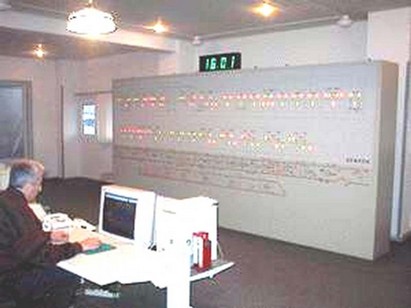SCADA for tele - management of Tbilisi underground power supply. - Semper Ltd Official Website (Eng)



Main menu:
SCADA for tele - management of Tbilisi underground power supply.

Financed with assistance from the World Bank, the power supply network for the Tbilisi underground in Georgia (South Caucasus) has been upgraded by system integrator, SEMPER, from a purely manual control system to an automated system using GE Fanuc's control and monitoring software, CIMPLICITY, and GE Fanuc PLCs. This has not only significantly increased productivity, but has also reduced running costs.
Sub-stations
The underground power supply system contains three different types of sub-station:
- One providing a direct 825V to the main contact rail.
- One containing a step-down transformer which powers other infrastructure such as lighting, ventilation and pumps. This supplies 380V, 220V and 110V.
- One containing a combination of these two.
Originally, personnel at each sub-station worked around the clock, manually switching units on and off at a telephone request from the dispatcher at a central location. They would then confirm their action by a return telephone call. Now all of these 26 sub-stations are controlled automatically from this central load dispatching centre (LDC). Distances between sub-stations are typically between 800m and 1900m, while the most remote one is around 20km away.
Control system
The automated control system has a two tier structure. The LDC is connected to 90-30 PLCs at each sub-station on the higher tier. Each 90-30 at the substations controls its equipment at a lower tier in accordance with commands received on the higher tier and supplies data back to the LDC.
The control system is based on 3 PCs in the central command station. the LDC. Two are used by operators, who oversee the smooth operation of the network, and one PC acts as the main server. These PCs run CIMPLICITY. The main server controls and monitors up to 35000 data points on the SCADA network. It generates alarm messages, if data received from the sub-stations move outside set limits, it archives historical data and operator actions, and it monitors system trends.
The operators sit at the two CIMPICITY Viewer stations, supporting the dispatch and receipt of data by the server. They have access to the main database, to adjust settings if needed, and they acknowledge and react to alarms. They can also display historical data. Each of the 26 sub-stations can be called up as a separate screen. Parts of the electrical circuits, or a piece of equipment in the sub-station, can be clicked on to display more detail along with the relevant current measurements.
The GE Fanuc 90-30 PLCs at the sub-station have been programmed using GE Fanuc’s Versa Pro software. They process the data to and from the LDC at the local level. Remote sub-stations are monitored and controlled by 90-30 PLCs communicating via dedicated telephone lines to two 90-30s on the network in the LDC. These 90-30s are fitted with modems, which are a standard option, and communicate data using the GE Fanuc protocol SNP-X.
Positive results
When the system was put into operation, the expectations of the system design were realized. The choice of GE Fanuc software and hardware has brought about greater protection and thus reliability of the electricity supply to the underground network. With all necessary information about the whole system available to the central dispatcher, it has enabled more flexible control. The greatly improved efficiency and central control has also led to money saving on a year-on-year basis.
And with the nature of the system design, and compatibility of any future upgrades of software, the control system can easily be extended with new hardware without any reconfiguration of the network.